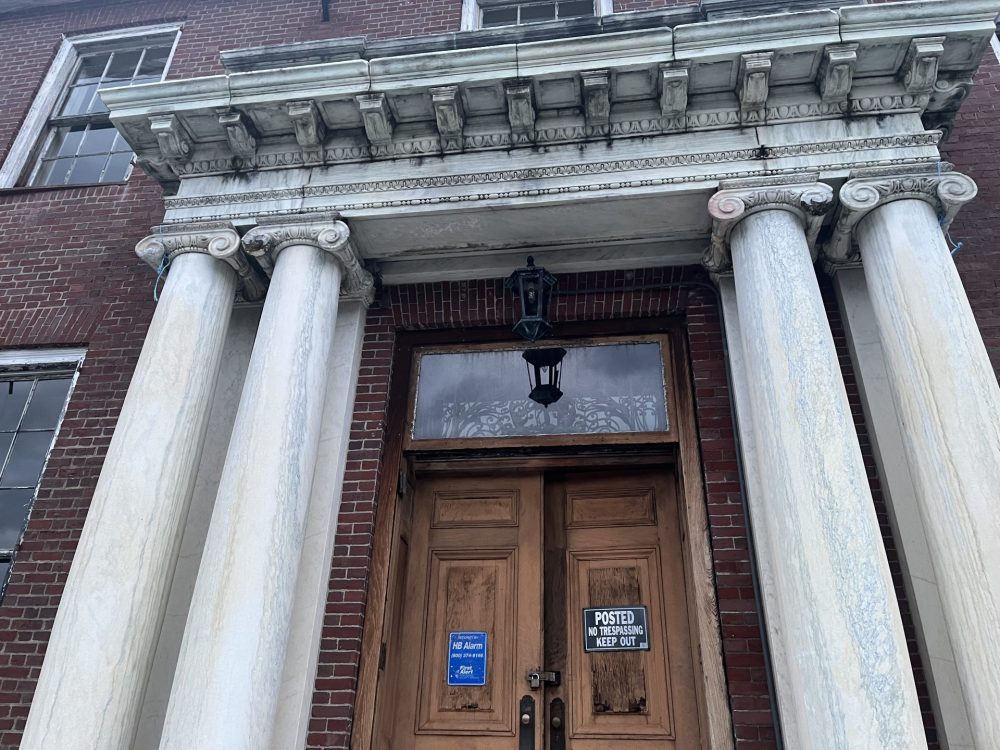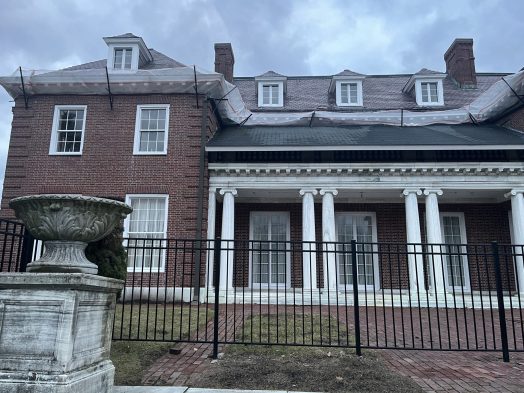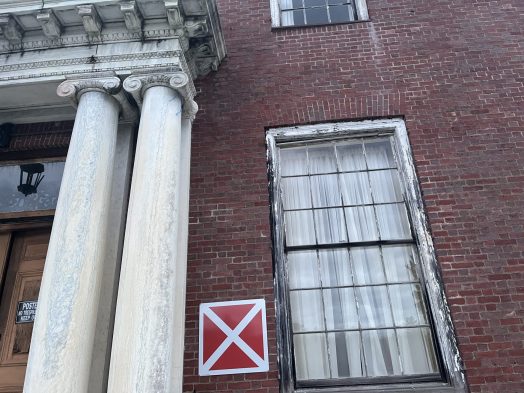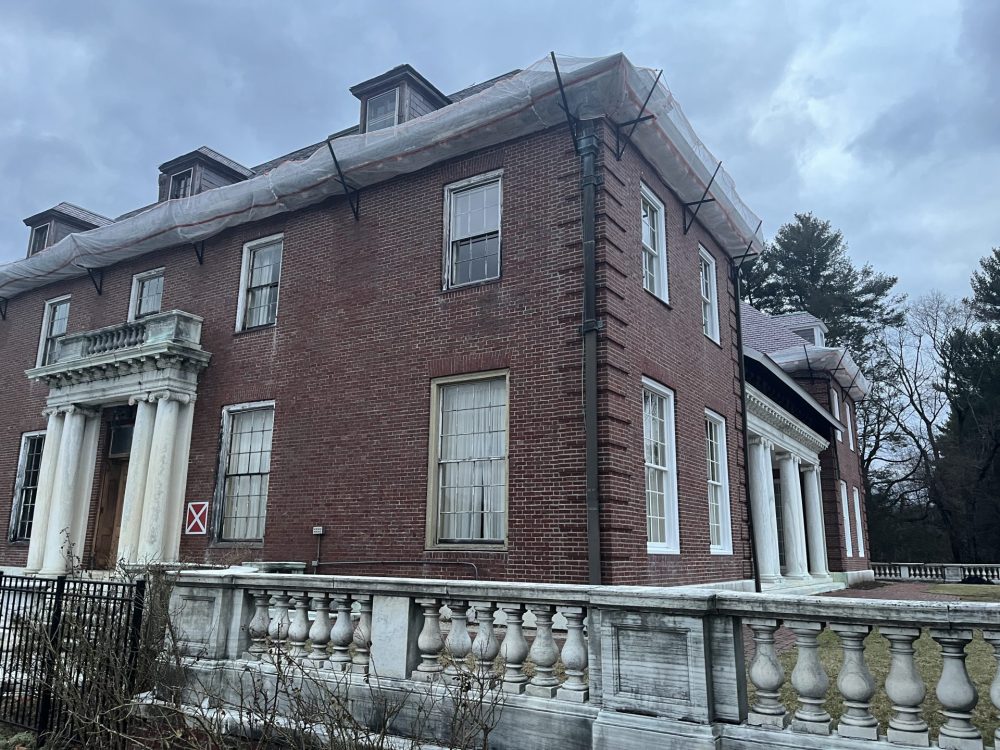Mass Hort hopeful that vacant Elm Bank manor house has lots of life left
When AMC filmed parts of its “Invitation to a Bonfire” series at the Cheney-Baltzell Manor House within Elm Bank Reservation last fall, park visitors were surprised to see the usually off-limits neo-Georgian building back in action. It’s been decades since the manor has been occupied, and only occasionally this century has it been used, such as for filming and antiques fairs. The team behind “Bonfire” had approached Mass Hort about using the building after noticing some work had been done on it.
AMC wound up scrapping its “Bonfire” production to cut costs, so the fate of that project is unclear. So too is the future of the manor house, but the Massachusetts Horticultural Society that calls Elm Bank (900 Washington St., Wellesley) its home is hopeful that there will be a future for the 1907 building that now looms vacant behind the striking Italianate garden.

An Update on the Manor House
Mass Hort Executive Director James Hearsum, named to that position in 2019, recently shared an update with us on the site of the 3-story building that possesses an inner beauty that shines through the deterioration (no inside photos allowed). Highlights include a classic ballroom and 2-story library (accessed via a sort of secret door… don’t lean on the balcony!), their shelves filled with real and fake books supplied during the filming of 2009’s “Ghosts of Girlfriends Past.” Also unique: more than a dozen commissioned marble fireplaces, each sent here from Italy following the original owners’ honeymoon in Europe.
The ground floor of the 40-room building remains in relatively good shape inside, though less stable temperatures on the upper floor have wreaked some havoc there. Fortunately, even though much plaster has turned to dust, the way the plaster was originally applied over a concrete base makes it “about a simple a restoration as you can do,” Hearsum says. There is lead paint to deal with as well, he adds.
Unfortunately, Hearsum acknowledges, the 36,000 sq. ft. condemned building, with its exterior marble steps and Ionic columns, has been low on the Society’s priority list because of the daunting cost to restore it. “When I came here in 2020 I wondered what we would be doing with this, and was told it would be a $20M to $25M restoration. Obviously there is no way on the planet we can fund that—nor should we. It’s not our mission,” he says.
In learning more about the building, and trying to get a handle on where the $20M-$25M figures came from, Hearsum says that “it was clear that it was tipping from restorable to not restorable” due to losing the water tightness of the building. “As soon as you lose the water tightness, you lose the building in a matter of a few years,” he says.


Hearsum began looking into what it would take to maintain the building envelope for the next 10 years, at least giving it a chance to remain viable. Hazardous material and structural surveys were conducted. On the plus side, it was structurally fine, but not unexpectedly, there was lots of asbestos to deal with in the basement. The building was restorable, but even at a modest per square foot cost for such a large building, you’re talking tens of millions of dollars, he says.
State politicians (Senators Rausch, Creem, and Rush among them) were then contacted to seek funding to keep the building intact. This would include addressing woodwork on the windows to prevent them from falling in or out, and keeping water from seeping into the basement, where utilities are located amidst the asbestos. The roof also has leaks, which could be fixed for a few hundred thousand (vs. a replacement that would cost millions). Mass Hort could find a couple or few hundred thousand dollars to put toward fixes (“we’ll stretch as far as we can…”), but it would really need the state to come through with more to effectively save the building, Hearsum says.
“We frankly didn’t expect to get it, but it wound up getting attached to the state budget for this past year,” says Hearsum, who credited many Mass Hort members from Wellesley and other communities for writing to their legislators in support of this investment. To Mass Hort’s surprise, $600K was appropriated, with asbestos abatement first on the list of jobs, starting this spring. Some painting and other woodwork restoration on windows on one facade has already been done, and Mass Hort has determined it will still need to raise $150,000-$200,000 for other work. Netting has been placed on the gutters to prevent parts of the roof from falling.
The state building inspector and town of Dover (where Elm Bank’s land resides) would need to sign off on any use of the property. It would most likely be cost prohibitive for Mass Hort to host events there, but AMC was able to pay for safety upgrades to allow filming for a few weeks. Given that that was done, it could be possible for Mass Hort to explore whether such existing safety investment would allow it to take advantage of that in hosting something. Hearsum was complimentary of the state and town’s willingness to support its efforts.
What would really be nice is if the manor house would catch the eye of not just film producers, but one of the many home makeover reality shows that might be willing to foot the bill.
Mass Hort feeling strong
While Mass Hort took an early hit during the pandemic, as weddings that would have been held on the Elm Bank grounds were canceled or postponed, Hearsum says the Society has come out of the past few years stronger organizationally and financially.
It is playing some catch-up, after being short staffed, and is sprucing up the pollinator area within Weezie’s Garden for Children and filling in the Bressingham Garden. It has been working more closely with Wellesley College, supporting internships, alumnae programs, and more.
The Society has also rethought its mission, which has long been a traditional approach to growing the art and science of horticulture, and promoting it. “We asked: ‘Is that significant enough?’ What we really do is help people have better lives through horticulture, helping at every stage of life,” Hearsum says. This translates into school programs that focus more on growing, efforts aimed at people transitioning from school to work, helping people going through various forms of rehabilitation. Hearsum points back to early Society work, back in the 1840s, helping new immigrants learn how to grow food in an unfamiliar climate.
“We kind of lost sight of all this, and had focused more on ‘Hey, pretty flowers,'” he says.
Not that Mass Hort, whose gardens are open from spring through fall, is eschewing pretty flowers. In fact, it will start spring with a bang in the form of a Tulip Mania festival during the first weeks of April. Some 53,000 tulip bulbs have been planted under netting in the trial garden for what should be a spectacularly colorful display, with cut flowers available for purchase.
Having a mission that supporters believe in will be important both for Mass Hort’s future, and possibly the manor house, Hearsum says.
Still, a huge challenge with the manor house is that those who might have an interest in restoring it would need something more to make a sustainable business of it. For example, the house plus a hotel or the house plus an arts center, Hearsum says.
“I am an optimist about this. I actually do believe this is restorable and worth restoring—otherwise we wouldn’t be sinking nearly a million dollars into it just to keep the possibilities alive,” he says. “You have to take a 20-year view though. If you take a 5-year view, there’s nothing we can do.”

- Please send tips, photos, ideas to theswellesleyreport@gmail.com
- Consider contributing to Swellesley to sustain our independent journalism venture